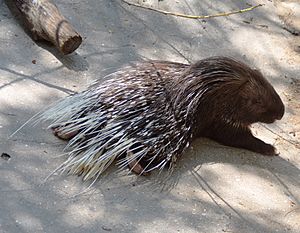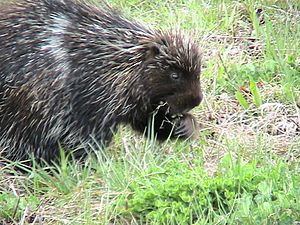Porcupine facts for kids
Quick facts for kids Porcupine |
|
|---|---|
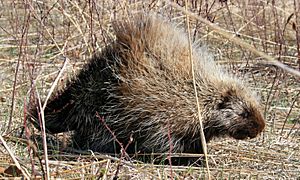 |
|
| North American porcupine | |
| Scientific classification | |
| Kingdom: | Animalia |
| Phylum: | Chordata |
| Class: | Mammalia |
| Order: | Rodentia |
| Suborder: | Hystricomorpha |
| Infraorder: | Hystricognathi |
| Groups included | |
|
|
| Cladistically included but traditionally excluded taxa | |
|
|
Porcupines are large rodents with coats of sharp spines, or quills, that protect them against predation. The term covers two families of animals: the Old World porcupines of the family Hystricidae, and the New World porcupines of the family Erethizontidae. Both families belong to the infraorder Hystricognathi within the profoundly diverse order Rodentia and display superficially similar coats of rigid or semi-rigid quills, which are modified hairs composed of keratin. Despite this, the two groups are distinct from one another and are not closely related to each other within the Hystricognathi. The largest species of porcupine is the third-largest living rodent in the world, after the capybara and beaver.
The Old World porcupines (Hystricidae) live in Italy, Asia (western and southern), and most of Africa. They are large, terrestrial, and strictly nocturnal.
The New World porcupines (Erethizontidae) are indigenous to North America and northern South America. They live in wooded areas and can climb trees, where some species spend their entire lives. They are less strictly nocturnal than their Old World counterparts and generally smaller.
Most porcupines are about 60–90 cm (25–36 in) long, with a 20–25 cm (8–10 in) long tail. Weighing 5–16 kg (12–35 lb), they are rounded, large, and slow, and use an aposematic strategy of defence. Porcupines' colouration consists of various shades of brown, grey and white. Porcupines' spiny protection resembles that of the only distantly related erinaceomorph hedgehogs and Australian monotreme echidnas as well as tenrecid tenrecs.
Contents
Etymology
The word "porcupine" comes from the Latin porcus pig + spina spine, quill, via Italian (Italian "porcospino", thorn-pig)—Middle French—Middle English. A regional American name for the animal is "quill-pig".
A baby porcupine is a porcupette. When born, a porcupette's quills are soft hair; they harden within a few days, forming the sharp quills of adults.
Evolution
Fossils belonging to the genus Hystrix date back to the late Miocene of the continent of Africa.
Species
Taxonomy
A porcupine is any of 30 species of rodents belonging to the families Erethizontidae (genera: Coendou, Erethizon, and Chaetomys) or Hystricidae (genera: Atherurus, Hystrix, and Trichys). Porcupines vary in size considerably: Rothschild's porcupine of South America weighs less than a kilogram (2.2 lb); the crested porcupine found in Italy, North Africa, and sub-Saharan Africa can grow to well over 27 kg (60 lb). The two families of porcupines are quite different, and although both belong to the Hystricognathi branch of the vast order Rodentia, they are not closely related.
Old World compared with New World species
The 11 Old World porcupines tend to be fairly large and have spines grouped in clusters.
The two subfamilies of New World porcupines are mostly smaller (although the North American porcupine reaches about 85 cm or 33 in in length and 18 kg or 40 lb), have their quills attached singly rather than grouped in clusters, and are excellent climbers, spending much of their time in trees. The New World porcupines evolved their spines independently (through convergent evolution) and are more closely related to several other families of rodents than they are to the Old World porcupines.
Longevity
Porcupines have a relatively high longevity and hold the record for being the longest-living rodent, with one individual named Cooper living over 32 years.
Diet
The North American porcupine is a herbivore and often climbs trees for food; it eats leaves, herbs, twigs, and green plants such as clover. In the winter, it may eat bark. The African porcupine is not a climber; instead, it forages on the ground. It is mostly nocturnal but will sometimes forage for food during the day, eating bark, roots, fruits, berries, and farm crops. Porcupines have become a pest in Kenya and are eaten as a delicacy.
Defence
Defensive behaviour displays in a porcupine depend on sight, scent, and sound. Often, these displays are shown when a porcupine becomes agitated or annoyed. There are four main displays seen in a porcupine: (in order from least to most aggressive) quill erection, teeth clattering, odour emission, and attack. A porcupine's colouring aids in part of its defence as most of the predators are nocturnal and colour-blind. A porcupine's markings are black and white. The dark body and coarse hair of the porcupine are dark brown/black and when quills are raised, present a white strip down its back mimicking the look of a skunk. This, along with the raising of the sharp quills, deters predators. Along with the raising of the quills, porcupines clatter their teeth to warn predators not to approach. The incisors vibrate against each other, the strike zone shifts back, and the cheek teeth clatter. This behaviour is often paired with body shivering, which is used to further display the dangerous quills. The rattling of quills is aided by the hollow quills at the back end of the porcupine. The use of odour is when the sight and sound have failed. An unpleasant scent is produced from the skin above the tail in times of stress and is often seen with a quill erection. If these processes fail, the porcupine will attack by running sideways or backwards into predators. A porcupine's tail can also be swung in the direction of the predator; if contact is made, the quills could be impaled into the predator causing injury or death.
Quills
Porcupines' quills, or spines, take on various forms, depending on the species, but all are modified hairs coated with thick plates of keratin, and embedded in the skin musculature. Old World porcupines have quills embedded in clusters, whereas in New World porcupines, single quills are interspersed with bristles, underfur, and hair.
Quills are released by contact or may drop out when the porcupine shakes its body. New quills grow to replace lost ones. Despite what is commonly believed, porcupines can't launch their quills at range.
There are some possible antibiotic properties within the quills, specifically associated with the free fatty acids coating the quills. The antibiotic properties are believed to aid a porcupine that has suffered from self-injury.
Uses by humans
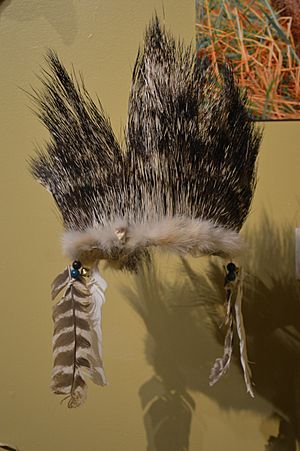
Porcupines are seldom eaten in Western culture but are eaten often in Southeast Asia, particularly Vietnam, where the prominent use of them as a food source has contributed to declines in porcupine populations. Naturalist William J. Long reported the taste of the North American porcupine as "vile" and "malodorous" and delightful only to a lover of strong cheese.
More commonly, their quills and guard hairs are used for traditional decorative clothing; for example, their guard hairs are used in the creation of the Native American "porky roach" headdress. The main quills may be dyed and then applied in combination with thread to embellish leather accessories, such as knife sheaths and leather bags. Lakota women would harvest the quills for quillwork by throwing a blanket over a porcupine and retrieving the quills left stuck in the blanket.
The presence of barbs, acting like anchors, causes increased pain when removing a quill that has pierced the skin. The shape of the barbs makes the quills effective for penetrating the skin and for remaining in place. The quills have inspired research for such applications as the design of hypodermic needles and surgical staples. In contrast to the current design for surgical staples, the porcupine quill and barb design would allow easy and painless insertion, as the staple would stay in the skin using the anchored barb design rather than being bent under the skin like traditional staples. Porcupines are also sometimes kept as exotic pets.
Habitat
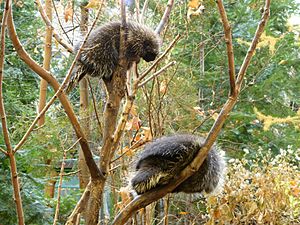
Porcupines occupy a small range of habitats in tropical and temperate parts of Asia, Southern Europe, Africa, and North and South America. They live in forests and deserts, rocky outcrops, and hillsides. Some New World porcupines live in trees, but Old World porcupines prefer a rocky environment. Porcupines can be found on rocky areas up to 3,700 m (12,100 ft) high. They are generally nocturnal but are occasionally active during daylight.

Classification
Porcupines are distributed into two evolutionarily independent groups within the suborder Hystricomorpha of the Rodentia.
- Infraorder Hystricognathi
- Family Hystricidae: Old World porcupines
- African brush-tailed porcupine, Atherurus africanus
- Asiatic brush-tailed porcupine, Atherurus macrourus
- Crested porcupine, Hystrix cristata
- Cape porcupine, Hystrix africaeaustralis
- Indian porcupine, Hystrix indicus
- Malayan porcupine, Hystrix brachyura
- Himalayan porcupine, Hystrix (brachyura) hodgsoni
- Sunda porcupine, Hystrix javanica
- Sumatran porcupine, Hystrix (Thecurus) sumatrae
- Thick-spined porcupine, Hystrix (Thecurus) crassispinis
- Philippine porcupine, Hystrix (Thecurus) pumilis
- Long-tailed porcupine, Trichys fasciculata
- Parvorder Phiomorpha sensu stricto
- Family Thryonomyidae: cane rats
- Family Petromuridae: Dassie rats
- Family Bathyergidae: African mole-rats
- Parvorder Caviomorpha
- Superfamily Erethizontoidea
- Family Erethizontidae: New World porcupines
- Brazilian porcupine, Coendou prehensilis
- Bicolored-spined porcupine, Coendou bicolor
- Andean porcupine, Coendou quichua
- Black dwarf (Koopman's) porcupine, Coendou nycthemera (koopmani)
- Rothschild's porcupine, Coendou rothschildi
- Santa Marta porcupine, Coendou sanctemartae
- Mexican hairy dwarf porcupine, Coendou mexicanus
- Paraguaian hairy dwarf porcupine, Coendou spinosus
- Bahia porcupine, Coendou insidiosus
- Brown hairy dwarf porcupine, Coendou vestitus
- Streaked dwarf porcupine, Coendou ichillus
- Black-tailed hairy dwarf porcupine, Coendou melanurus
- Roosmalen's dwarf porcupine, Coendou roosmalenorum
- Frosted hairy dwarf porcupine, Coendou pruinosus
- Stump-tailed porcupine, Coendou rufescens
- North American porcupine, Erethizon dorsatum
- Bristle-spined porcupine, Chaetomys subspinosus (sometimes considered an echimyid)
- Family Erethizontidae: New World porcupines
- Superfamily Cavioidea
- Family Hydrochaeridae: capybara
- Family Caviidae: Guinea-pigs
- Family Dasyproctidae: agoutis and acouchis
- Superfamily Octodontoidea
- Family Abrocomidae: chinchilla-rats
- Family Octodontidae: degus
- Family Ctenomyidae: tuco-tucos
- Family Echimyidae: spiny rats
- Family Myocastoridae: nutrias
- Family Capromyidae: hutias
- Superfamily Chinchilloidea
- Family Chinchillidae: chinchillas and allies
- Family Dinomyidae: pacaranas
- Superfamily Erethizontoidea
- Family Hystricidae: Old World porcupines
See also
 In Spanish: Puercoespín para niños
In Spanish: Puercoespín para niños
- Pangolins, another mammal group with protective keratin body coverings
- Armadillos, another mammal group with protective keratin body coverings


